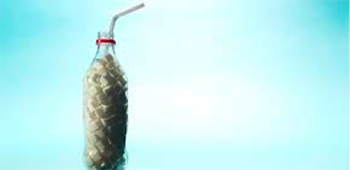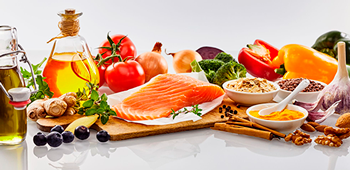Salt and health
Sodium chloride or table salt is the major source of salt in our diet. Together with potassium, is necessary to regulate the level of liquids in the body and for the transmission of nerve and muscle impulses [1]. Although it is very unlikely for us to consume too little, it is very easy for us to consume too much. Not surprisingly, most of the salt that enters our system does so via processed foods.
About 75% of the sodium we eat comes from processed foods and salty favorites aren’t the only culprits; pastries and breakfast cereals can also pack high amounts of sodium.
Our body’s need of sodium is actually very low. Our physiological need for it is only around 500 mg per day [1]; however, in our current living conditions and with the way we produce and process food, it is nearly impossible to consume that little. In fact, most Americans consume an average of 3,393 mg of sodium per day, which is almost double than what is recommended to prevent any health risks.
Current recommendations suggest that a healthy adult should consume no more than 2,300 mg of sodium per day and those who suffer from hypertension should limit their intake to 1,500 mg. Those who suffer from more complicated diseases of the heart, liver or kidneys have to cut down even more.
Here are the recommended amounts of sodium according to the Chronic Disease Risk Reduction levels. According to these guidelines, kids should consume half as much as adults.
| Age | Chronic Disease Risk Reduction levels of sodium [2] |
| Toddlers aged 1 to 3 | 1,200 mg per day |
| Kids aged 4 to 8 | 1,500 mg per day |
| Young kids aged 9 to 13 | 1,800 mg per day |
| Older than 13 | 2,300 mg per day |
What is dangerous about having too much sodium in your diet is that it overworks your system. When sodium builds up, the body retains water to dilute the excess; this increases fluid level around the cells and blood volume: increased blood volume means extra work for the heart and increased pressure to the arteries. Eventually the arteries can harden, giving way to hypertension and increasing the risk of heart attack or stroke.
The effect of reducing salt by 3 g/day would reduce strokes by 13% and ischaemic heart disease by 10%. This effect would be doubled and tripled if reductions of 6 g/day and 9 g/day respectively, took place across the general population [1].
Hypertension is one of the main causes of heart disease and is responsible for half of the heart attacks that occur in the United States each year. But even if you do not suffer from high blood pressure; that does not mean that a diet high in sodium is not significantly affecting your heart and the rest of your body, studies have found a relationship between excessive sodium consumption and diseases such as cancer of the stomach and osteoporosis.
Regardless of age or condition, we should all watch our salt intake, but Harvard’s School of Public Health says that adults over 50, people with high or slightly high blood pressure and those with diabetes have to be especially careful.
More recent studies have found a strong association between high sodium diets and obesity. One of the reasons may be that too much salt produces thirst and this may increase the consumption of caloric beverages, but the strongest relationship could be that many of those who suffer from obesity have gained their excess weight by following a diet based on processed foods that contain far more sodium, sugar and calories than what experts recommend.
Some of the harmful effects of a high-salt diet are:
Here is a brief summary of which are the most adverse side effects that a high consumption of salt has:
- Increased blood pressure
- Increased risk of stroke
- Fluid retention
- Calcium loss
- Osteoporosis
- Cancer of esophagus and stomach
- Left ventricular hypertrophy
- Asthma
- Impaired renal function [1]
How to reduce our salt intake
We can’t take the sodium out of processed foods, so it becomes increasingly important for us to learn how to read labels and choose low sodium foods and beverages. Reducing salt intake can be a challenge, because our taste buds are used to a diet high in salt and if we get rid of it all together food will be quite unappealing. A much better choice is to reduce salt intake gradually, while at the same time experimenting with various seasonings and spices. Sea salt or the colored salts that have become so popular are not necessarily healthier; they can provide small amounts of other necessary minerals, but the effect on the body remains the same. It is important to watch our salt intake in general.
Here are some practical tips you can follow to reduce your salt consumption:
- Reduce intake of high-salt processed foods such as fast foods, bread, breakfast cereals, processed meat products, soups, pizzas, instant packet foods and yeast extracts.
- Try cooking at home more often
- Choose breakfast cereals with no added salt.
- Make a habit out of reading food labels to select products with the lowest salt content. Use the Nutrition Facts label to choose products with less sodium, reduced sodium, or no-salt added, etc.
- Don’t add salt to your food. Prefer pepper, vinegar or lemon to add more flavor to your foods.
- Remember that sea, rock and garlic salt carry the same effects as the regular kind. They may be adding more minerals or ingredients, but their consequences on the body are the same.
- Avoid soy sauce and ketchup. They have a very high amount of sodium.
- Don’t add salt to cooking water or ingredients while cooking.
- Don’t use stock cubes. Prefer natural ingredients and flavors like herbs, spices, onions, garlic, etc.
- If you feel like you can’t live without salt, choose a mineral salt with potassium instead. It has less sodium than the regular kind.
It is better to reduce your salt-intake gradually so you can give a change for your taste buds to adjust. If you make drastic changes too quickly, you might not be able to enjoy or appreciate your food. People should be aware that it may take 2 to 4 weeks for their taste buds to adapt to a lower salt diet. After this time, salt receptors become more sensitive to its taste, which makes it more unpleasing to the palate.
Reducing your eating portions can also contribute to reducing your salt-intake. The more calories you consume, the more sodium you consume too; so eating smaller portions of meals can also help you reduce your sodium intake.
Some high sodium foods to watch out for are:
Consumers are often unaware of which foods are high on sodium. There are many reasons why the food industry uses too much salt in their products. One of them is that salt and sodium helps to extend the shelf-life of products and prevents the growth of micro-organisms. So, salt helps preserve foods longer. Another reason is simply to add taste or flavor to ingredients.
However, there have been coordinated efforts to reduce the amount of sodium in processed foods around the world and in some countries like United States and Mexico. We will comment more on this in the next segment.
In the meantime, it is important to identify foods are usually very high on sodium so we can either avoid them or eat them in small portions. Some top sources of sodium in a regular diet are:
- Processed meats
- Cold cuts
- Canned or pre-packaged soups
- Bread
- French fries
- Some breakfast cereals
- Snacks like chips or peanuts
- Prepared cocktails such as margaritas or sports drinks
- Bottled sauces, soy sauce, ketchup and sweet and sour candies
The British Heart Foundation lists the following foods as significant and sometime surprising sources of sodium:
- Sandwiches
- Cheese and butter
- Sauces and chutneys
- Ingredients such as olives, capers, jerkey and anchovies
- Desserts and pastries
- Sweet and sour meals
Reduce your intake of junk or processed foods and try to cook with less added salt. Get creative and season your dishes with ingredients such as vinegar, lemon juice, onion, garlic, chili powder and spices. Be patient, your palate will get used to cleaner flavors in no time!
International and national efforts to reduce sodium consumption
The World Health Organization set a global target of reducing the population salt-intake from the current level of approximately 10 g daily to less than 5 g daily. With this, every nation worldwide should adopt measures to meet this goal. In the United States, the Centers for Disease Control and Prevention (CDC) has set sodium reduction as a national priority. The CDC’s goal is to reduce sodium intake by 20% to prevent 1 million heart attacks and strokes by 2022 [3]. Some of these health policies were designed more than 9 years ago and are planned keep on effect during the next following years, in a way that the food industry and retailers can gradually reduce the salt in their products.
Some of the food manufacturers that have committed to reducing salt in their products are:
- Au Bon Pain
- Bertucci’s Italian Restaurant
- Black Bear European Style Deli
- Boar’s Head Provisions Co.
- Butterball
- Campbell Soup Company
- Delhaize America
- Dietz & Watson
- FreshDirect
- Furmano’s
- Goya Foods
- Hain Celestial
- Heinz
- Hostess
- Ken’s Foods
- Kraft Foods / Mondēlez International
- LiDestri Foods / Francesco Rinaldi
- Mars Food US
- McCain Foods
- Premio
- Red Gold, Inc.
- Snyder’s-Lance, Inc.
- Starbucks Coffee Company
- Subway®
- Target Corporation
- Unilever
- Uno Chicago Grill
- White Rose [4]
Other fast food chains like Burger King and McDonalds have also reduced their salt levels throughout the years [1].
In this sense, reducing our salt intake is a very important measure that every body should take, both with our individual every day choices and decisions on what to eat, and with collective efforts of reducing the availability of salty foods in the market.
Contact us
If you are worried about what salt is doing to your health or that of a loved one, and especially if excess weight or obesity is part of the picture, please contact us. We can help transform your life and claim back your health. For a free evaluation call LIMARP International Center of Excellence for Obesity at (664) 686 2542 or fill out a contact form at www.limarp.com.
References
[1] P. A. Gilbert and G. Heiser, “Salt and health: the CASH and BPA perspective,” Nutr. Bull., vol. 30, no. 1, pp. 62–69, Mar. 2005, doi: 10.1111/j.1467-3010.2005.00484.x.
[2] U.S. Department of Agriculture (USDA) and U.S. Department of Health and Human Services, Dietary Guidelines for Americans, 2020-2025, 9th ed. 2020. [Online]. Available: https://www.dietaryguidelines.gov/sites/default/files/2021-03/Dietary_Guidelines_for_Americans-2020-2025.pdf
[3] CDC, “CDC Sodium Reduction Initiative,” Centers for Disease Control and Prevention, Dec. 15, 2020. https://www.cdc.gov/salt/sodium_reduction_initiative.htm (accessed Jan. 20, 2022).
[4] NYC Health, “National Salt and Sugar Reduction Initiative (NSSRI).” https://www1.nyc.gov/site/doh/health/health-topics/national-salt-sugar-reduction-initiative.page


